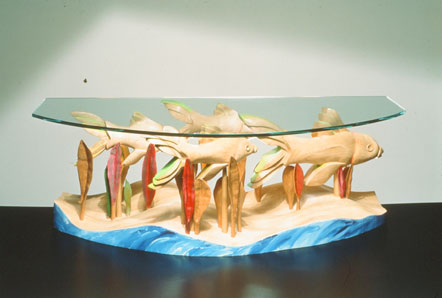
Kathran Siegel builds some very unusual furniture. To call it artistic is too timid. She herself calls it imagistic.
Making sure that her furniture works on a lot of levels is very important to Kathran. She does that by integrating her imagery into furniture that can be used every day. So while her coffee table may look pretty radical, it still functions quite well as a coffee table.
She used to make pieces that were closer to art than they were to furniture, but she’s moving away from that in her current work. “I felt like I wanted to begin to address some other kinds of issues that have to do with living. [Work she did in the past] was very limited in the kinds of clientele that could go for it. You had to have a very big space and a big wallet,” she admits.
Now she’s using the concept of still life imagery to create artistic furniture that works on a lot of levels. She will build a table and carve some accesories that go with the table so that the customer can set up a scene that looks like a still life, but can also disassemble the image and just use the table for breakfast. As Kathran puts it, “the furniture can have a life of its own in the real world. Or if you viewed it with the objects I carved around it…you could view it as part of a still life.”
Her past works, she says, took up a lot of space and were more like sculpture. Consequently, only people with big houses could fit them in their lives. When she moved to smaller digs, she began to think about making pieces that fit into smaller spaces. That got her thinking about ways to break down larger pieces of furniture into separate, smaller pieces. For example, she has one table that can break down into two smaller tables and be reassembled using a wooden hinge. She jokes that her background in Tinker Toys helps her do some of this work. A lot of her joinery is done with dowels.
Kathran has a background in painting and drawing, but admits she’s never been much good at it. She struggled with rendering images in two dimensions, but when she started woodcarving in college, it all came together for her. “I discovered that I could look at something and I could carve it and render it, but I couldn’t draw it,” she says. It’s no surprise, therefore, that she doesn’t build furniture from drawings. She first makes a maquette, a small model, of the piece and builds it based on that. “What I found was that if you do it small scale and you work everything out there, for the most part, it translates,” says Kathran, “whatever your problems with balance are in the small scale, it’s not that different when you go larger.”
She prefers blonde woods for her furniture because she often paints a portion of her pieces. She also does a lot of carving on the pieces she creates. One of her favorite tools for carving is a die grinder. She was at a show trying to take off a lot of material with a small multi-tool, burning through a lot of motors in the process. One of the other woodworkers at the show introduced her to the die grinder and its attachments and it has become her favorite tool. She also uses a power hand planer for some of her work and a chainsaw when the work warrants it. “It’s actually a pretty gentle tool,” Kathran says of her chainsaw, “it looks like it’s just eating the wood up, but it only takes a layer and then the wood is good beyond that. It’s like a big file in a way.”
– Bob Filipczak





